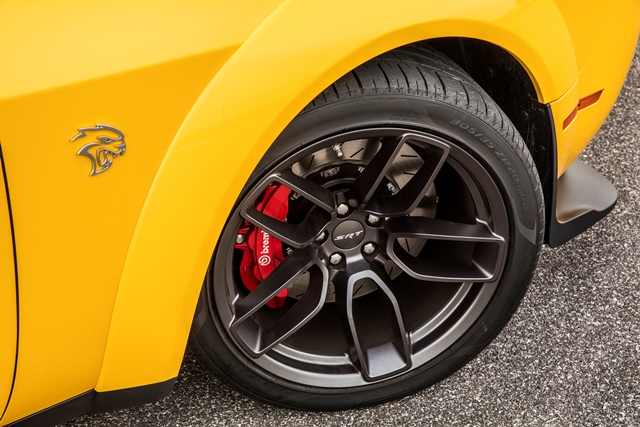INDIANAPOLIS – Push the “Launch Control” button, punch the accelerator, release the brake – and then hang on to the steering wheel as the Dodge Challenger SRT Demon digs for traction, hoists its hood and hurtles down the dragstrip in less time than it takes to tell.
Achieving what seems like terminal velocity in this devil-may-care version of the Challenger is a treat we get to enjoy for an afternoon here at Lucas Oil Speedway. But owners of FCA’s street-legal drag racer could find themselves making sub-10-second quarter-mile runs again and again, and then motoring home in relative anonymity.
“Relative” is the key word here, because nothing about this latest top-level performance car from Dodge is subdued. But despite its 840-hp V-8, monster tires and hood scoop and window-rattling exhaust roar, we did find it possible to drive within legal limits on local roads without drawing black helicopters and SWAT teams.
Dodge says single-year Demon production is limited to 3,000 copies, and the car’s $84,995 (plus $1,095 destination) sticker and its dragstrip design likely will limit its appeal to only the most committed muscle-car enthusiasts with the checkbook to back it up.
Suddenly, the 707-hp Challenger SRT Hellcat now in its fourth year of production seems like the sane little sister, a sibling still packing a wicked growl but no longer sitting on SRT’s top shelf. For the ’18 model year, Dodge adds a Widebody version of the Hellcat with Demon-derived broad fenders allowing for bigger wheels and tires to give the car better traction and improved handling.

For such a large coupe, we found the Widebody near-impossible to unsettle on the track thanks to extra grip provided by its larger 20 x 11-in. “Devil’s Rim wheels and 305/35ZR20 Pirelli P-Zero performance tires. Like its regular-sized sibling and big-brother Demon, the SRT Hellcat Widebody can be driven legally on public roads, but only through judicious application of the right pedal. Speed comes on so quickly it’s surprisingly easy to become velocitized in the Hellcat.
But the vehicle destined to ring the cash register for Dodge is the all-new ’18 Durango SRT, derived from the Jeep Grand Cherokee SRT but some 5 ins. (127 mm) longer and offering seating for up to six passengers.
Dubbed the “3-row Charger,” the Durango SRT is powered by a 6.4L Hemi V-8 producing 475 hp and 470 lb.-ft. (637 Nm) of torque, giving it an 8,700-lb. (3,946-kg) towing capacity and the ability to sprint from 0-60 mph (97 km/h) in 4.4 seconds.
Handling and performance is tuned for a 45 to 55-year-old male buyer who “needs extra cargo capability but loves the idea of a muscle car,” says Tim Kuniskis, head of Passenger Cars Brands, Dodge, SRT, Chrysler and Fiat, FCA-North America. Exhaust tuning is on the loud side and transmission shifts are abrupt by design.
“Those are things you normally wouldn’t do in a utility vehicle, but you would do in a utility vehicle like this,” he says.
The SRT-tuned Durango is a star on the track, with good grip and cornering capability seemingly at odds with its 5,510-lb. (2,499-kg) curb weight. Straight-line acceleration is absurd, with the engine running to redline as the 8-speed automatic transmission bangs through a series of relatively harsh shifts.
Sport mode (one of seven driver-selectable options) cuts shift times 50% while sending 65% of the available torque rearward; in Track mode, shifts are even swifter, and 70% of torque flows to the rear axle.

Alternatively, in a short test drive of the Durango SRT towing a 7,000-lb. (3,175-kg) powerboat, we found the vehicle provided plenty of pull, good stability and ample braking. Thankfully, active noise cancellation automatically turns on in Tow mode to abate the exhaust system’s below-3,000-rpm drone. The system uses the same ceiling-mounted microphone pickups as installed in the Grand Cherokee SRT (but with one pickup moved rearward to the third-row ceiling) to “hear” the exhaust frequency and then broadcast an offsetting frequency to effectively eliminate the cacophony from the twin exhaust outlets.
Kuniskis says the SRT will account for less than 10% of Durango annual sales, with Hemi-powered R/T models tallying about 25% of the model’s volume. Dodge sold 68,474 Durangos in 2016, according to WardsAuto data.
“A 4-second, 3-row family vehicle is a sliver of the population,” Kuniskis concedes.
But the Durango SRT might cut a wider swath than expected, in part because it’s a V8-powered rear-driver in a front-drive-biased segment.
The SRT’s added towing capacity should give the midsize Durango an extra edge in a market where it is often cross-shopped against large SUVs such as the Chevrolet Tahoe that have higher towing and maximum load ratings. But that’s no longer the case with the Durango SRT, which now outclasses the Tahoe by 100 lbs. (45 kg) in towing, Kuniskis says.
And for those who find the SRT’s $62,995 (plus $1,095 destination) price tag a bit rich, the same Hellcat-derived SRT styling is now standard on Durango R/Ts starting at $40,000.
“We know that the successful formula for Dodge is being different from other cars in the segment, and Durango is no different,” Kuniskis says.
The ’18 Durango SRT goes on sale late this year.
[email protected] @bobgritzinger





